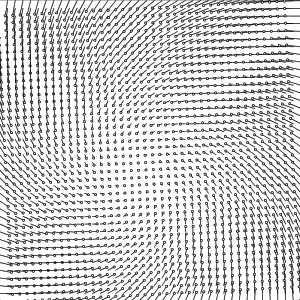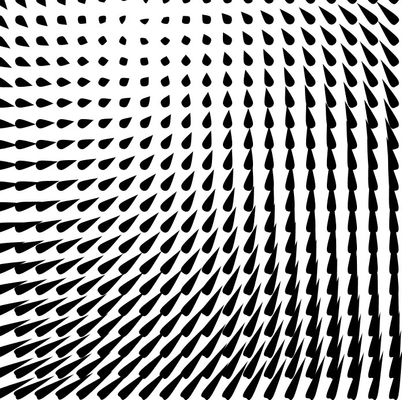Vector Fields
int gridWidth = 40;
int gridHeight = 40;
int screenWidth = 700;
int screenHeight = 700;
int distX;
int distY;
PVector reactorPosition;
ArrayList <VectorLine> vectLineList = new ArrayList<VectorLine>();
void setup() {
reactorPosition = new PVector(0, 0);
size(700, 700);
background(255);
stroke(0);
int distX = width/gridWidth+1;
int distY = height/gridHeight+1;
for (int i = 0; i<gridWidth; i++ ) {
for (int j = 0; j<gridHeight; j++ ) {
vectLineList.add(new VectorLine(i*distX, j*distY));
}
}
};
void draw() {
background(255);
for (int i = 0; i<vectLineList.size(); i++ ) {
vectLineList.get(i).draw(reactorPosition);
};
};
void mouseMoved() {
reactorPosition.x = mouseX;
reactorPosition.y = mouseY;
};
class VectorLine {
PVector _pos;
PVector _vector;
float reactorScaler = .07;
VectorLine(int x, int y) {
_vector = new PVector(0, 5);
_pos = new PVector(x, y);
_vector.add(_pos);
}
void draw(PVector reactor) {
PVector _reactor = reactor.copy();
float reactorDistance = dist(_reactor.x, _reactor.y, _pos.x, _pos.y);
float scaler = reactorDistance*reactorScaler;
_reactor.sub(_pos); // subtract VectorLines position from the reactors position, this effectively gives a reactor coordinate relative to our VectorLine coordinate
_vector = _reactor.copy();
_vector.normalize();
_vector.rotate(PI/4);
_vector.mult(scaler);
_vector.add(_pos);
//
line(_pos.x, _pos.y, _vector.x, _vector.y);
ellipse(_vector.x, _vector.y, 5, 5);
}
}
Example
This is an example solution for the exercises to create a tear-drop form.
int gridWidth = 20;
int gridHeight = 20;
int screenWidth = 700;
int screenHeight = 700;
int distX;
int distY;
PVector reactorPosition;
ArrayList <VectorLine> vectLineList = new ArrayList<VectorLine>();
void setup() {
reactorPosition = new PVector(0, 0);
size(700, 700);
int distX = width/gridWidth+1;
int distY = height/gridHeight+1;
for (int i = 0; i<gridWidth; i++ ) {
for (int j = 0; j<gridHeight; j++ ) {
vectLineList.add(new VectorLine(i*distX, j*distY));
}
}
};
void draw() {
background(255);
for (int i = 0; i<vectLineList.size (); i++ ) {
vectLineList.get(i).draw(reactorPosition);
};
};
void mouseMoved() {
reactorPosition.x = mouseX;
reactorPosition.y = mouseY;
};
class VectorLine {
PVector _pos;
PVector _vector;
float reactorScaler = .1;
VectorLine(int x, int y) {
_vector = new PVector(0, 5);
_pos = new PVector(x, y);
_vector.add(_pos);
}
void draw(PVector reactor) {
float reactorDistance = dist(reactor.x, reactor.y, _pos.x, _pos.y);
float scaler = reactorDistance*reactorScaler;
PVector _reactor = reactor.copy();
_reactor.sub(_pos);
_vector = _reactor.copy();
_vector.normalize();
_vector.rotate(PI/4);
PVector _pointTwo = _vector.copy();
_pointTwo.rotate(PI/2);
_pointTwo.mult(8);
PVector _pointTree = _pointTwo.copy();
_pointTree.rotate(PI/2);
PVector _pointFour = _pointTree.copy();
_pointFour.rotate(PI/2);
_pointTwo.add(_pos);
_pointTree.add(_pos);
_pointFour.add(_pos);
_vector.mult(scaler);
_vector.add(_pos);
noStroke();
fill(0);
beginShape();
curveVertex(_vector.x, _vector.y);
curveVertex(_vector.x, _vector.y);
curveVertex(_pointTwo.x, _pointTwo.y);
curveVertex(_pointTree.x, _pointTree.y);
curveVertex(_pointFour.x, _pointFour.y);
curveVertex(_vector.x, _vector.y);
curveVertex(_vector.x, _vector.y);
endShape();
}
}

